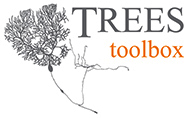
adapted from
PLoS supp. material
by Hermann Cuntz

![]()

The direct comparison of two trees along strict criteria requires
(apart from a unique label distribution) a unique distribution
of node locations on the graph. The process of manual reconstruction
attributes node locations in an arbitrary manner.
However, nodes can be redistributed on the same tree structure
assigning homogeneous inter-nodal distances,
a process we term resampling (see “resample_tree”).
Resampling compromises either the total length
(see loss resampling) or the shape of the neuronal tree
(see length conservation) when undersampling.
This is because a tortuous path is simplified by a straight line (always shorter).
If the length is conserved then the shape of the neuronal tree is altered
(the tree spannning field becomes larger, see length conservation).
A zig-zag implementation of resampling would best remediate
this but would also alter the original shape of the tree (and was not implemented).
The resulting electrotonic signature or BCT string will then be entirely independent
of the reconstruction procedure.
Furthermore, simplified tree structures,
which preserve the electrotonic compartmentalization, can be obtained.
Computing current flow in a corresponding model will be much faster
since the number of nodes is decreased drastically
(from 297 to 39 in the example on the far right).


This work is licensed under a
Creative Commons Attribution-Noncommercial-Share Alike 3.0 License